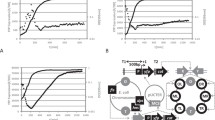Abstract
Gene activation by a DNA-binding regulatory protein in yeast requires the protein to have two components: one to recognize a specific DNA sequence and a second, the 'activating region', to interact with a general transcription factor or perhaps with RNA polymerase1,2. The activating regions that have been characterized are acidic3,4, and mutational analysis of one indicates that this acidity is important for activity6. Here we report the design of an artificial protein bearing a novel 15-amino acid peptide linked to a DNA binding fragment of the yeast regulatory protein GAL4 (refs 7–10). The synthetic peptide is acidic and should it form an α-helix, that helix would be amphipathic, having one hydrophilic face bearing the acidic residues, and one hydrophobic face11. When expressed in yeast, the artificial protein bearing this peptide efficiently activates the GAL1 gene which is ordinarily activated by GAL4 (refs 12, 13). An otherwise identical protein with the novel 15 amino acids in a scrambled order, and which is thus unable to form an amphipathic structure, does not activate GAL1 transcription.
Similar content being viewed by others
References
1. Ptashne, M. Nature 322, 697-701 (1986). 2. Struhl, K. Cell 49, 295-297 (1987). 3. Hope, I. A. & Struhl, K. Cell 46, 885-894 (1986). 4. Ma, J. & Ptashne, M. Cell 48, 847-853 (1987). 5. Ma, J. & Ptashne, M. Cell 51, 113-119 (1987). 6. Gill, G. & Ptashne, M. Cell 51, 121-126 (1987). 7. Klar, A. & Halvorsen, H. Molec. gen. Genet. 135, 203-212 (1974). 8. Bram, R. & Kornberg, R. D. Proc. natn. Acad. Sci. U.S.A. 82, 43-47 (1985). 9. Giniger, E., Varnum, S. M. & Ptashne, M. Cell 40, 767-774 (1985). 10. Keegan, L., Gill, G. & Ptashne, M. Science 231, 699-704 (1986). 11. O'Neil, K. T., Wolfe, H. R. Jr, Erickson-Viitanen, S. & DeGrado, W. F. Science 236, 1454-1456 (1987). 12. Hopper, J., Broach, J. & Rowe, L. Proc. natn. Acad. Sci. U.S.A. 75, 2878-2882 (1978). 13. St. John, T. & Davis, R. /. molec. Biol. 152, 285-315 (1981). 14. West, R. Jr, Yocum, R. & Ptashne, M. Molec. cell. Biol. 4, 2467-2478 (1984). 15. Yocum, R., Hanley, S., West, R. Jr & Ptashne, M. Molec. cell. Biol. 4, 1985-1998 (1984). 16. Maniatis, T., Fritsch, E. & Sambrook, J. Molecular Cloning, a Laboratory Manual (Cold Spring Harbor, New York, 1982). 17. Ito, H., Fukuda, Y., Murata, K. K Kimura, A. J. Bact. 153, 163-168 (1983). 18. Sherman, F., Fink, G. & Hicks, J. Methods in Yeast Genetics (Cold Spring Harbor, New York, 1983). 19. Wharton, R. P. thesis, Harvard Univ. (1986). 20. Silver, P. A., Keegan, L. P. & Ptashne, M. Proc. natn. Acad. Sci. U.S.A. 81, 5951-5955 (1984). 21. Church, G. & Gilbert, W. Proc. natn. Acad. Sci. U.S.A. 81, 1991-1995 (1984). 22. Pabo, C. O. & Lewis, M. Nature 298, 443-447 (1982). 23. Hochschild, A., Irwin, N. & Ptashne, M. Cell 32, 319-325 (1983). 24. Anderson, J. A., Ptashne, M. & Harrison, S. C. Nature 316, 596-601 (1985). 25. Bushman, F. D. & Ptashne, M. Proc. natn. Acad. Sci. U.S.A. 83, 9353-9357 (1986). 26. Eisenberg, D., Schwarz, E., Komaromy, M. & Wall, R. J. molec. Biol. 179, 125-142 (1984). 27. Erickson-Viitanen, S. & DeGrado, W. F. Meth. Enzym. 139, 455-478 (1987). 28. Chothia, C., Levitt, M. & Richardson, D. J. molec. Biol. 145, 215-250 (1981).
Author information
Authors and Affiliations
Rights and permissions
About this article
Cite this article
Giniger, E., Ptashne, M. Transcription in yeast activated by a putative amphipathic α helix linked to a DNA binding unit. Nature 330, 670–672 (1987). https://doi.org/10.1038/330670a0
Received:
Accepted:
Issue Date:
DOI: https://doi.org/10.1038/330670a0
- Springer Nature Limited
This article is cited by
-
Nucleosome distortion as a possible mechanism of transcription activation domain function
Epigenetics & Chromatin (2016)
-
Moonlighting transcriptional activation function of a fungal sulfur metabolism enzyme
Scientific Reports (2016)
-
Insights into kinetochore–DNA interactions from the structure of Cep3Δ
EMBO reports (2008)
-
Transcriptional analysis of themtA idiomorph ofNeurospora crassa identifies two genes in addition tomtA-1
Molecular and General Genetics MGG (1996)
-
Nucleosome disruption and enhancement of activator binding by a human SW1/SNF complex
Nature (1994)





